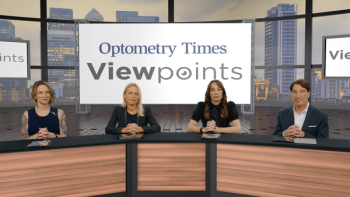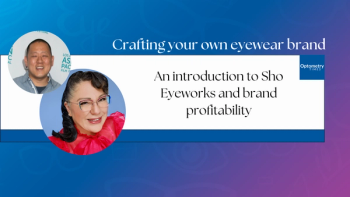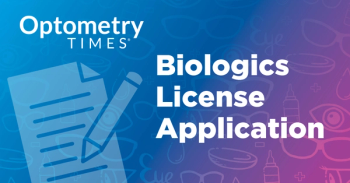
- July/August digital edition 2025
- Volume 17
- Issue 04
Embracing dry eye

Due to ubiquity, optometrists tend to undertreat patients with dry eye.
Dry eye is an everyday occurrence in optometry practices. The problem is that dry eye occurs at such a high prevalence that it almost becomes routine for doctors to the point that it is overlooked. Worse yet, because so many of our patients have complaints of dry eye, there is a tendency for doctors to trivialize the symptoms and undertreat these patients. The fact is that dry eye or symptoms of dry eye are ubiquitous in an optometric practice. And to the patients presenting with these conditions, the symptoms are not merely a nuisance but are very bothersome. They likely present to our practices because of these very symptoms, and if we do not address their condition, they most assuredly will find another eye doctor who will.
Dry eye by the numbers
The American Optometric Association has stated that 1 in 4 optometric patients report symptoms of dry eye. The American Academy of Ophthalmology has published that, other than blurry vision, symptoms of dry eye were the most common reason people sought eye care in 2022.1 Additionally, more than 150,000 dry eye procedures were performed that same year. The fact that more than $1 billion has been spent on 1 dry eye drug (Restasis; AbbVie) screams of the demand that dry eye creates. Due to our aging population and increased use of digital devices, the incidence is expected to continue to grow.
Not only is dry eye continuing to affect more people, but the severity of the disease seems to be worsening. On average, patients experienced dry eyes for 6.5 years, with 26% saying they have been affected for more than 10 years. Overall, the majority (76%) of patients report that their dry eye worsened over time (Data on file, Allergan), and 82.9% of those patients reported that their symptoms affected their ability to perform normal daily activities a great deal of the time or very often. Patients with moderate dry eye, as defined by mild corneal staining, report that their symptoms affect their quality of life to nearly the same level as patients who experience moderate angina.2 For our patients who experience dry eye, it is not just dry eye, but rather a debilitating disease.
The dry eye opportunity
Rather than seeing patients with dry eye as nuisances, we should view them as an opportunity to grow our practice and help a great deal of people. But how do we go about this (Figure 1)?
The best way to identify patients with dry eye is within the context of a comprehensive examination, specifically, the pre-exam workup as performed by our technicians. Techs should be trained to ask specific questions about dry eye and listen for certain buzzwords that indicate symptoms of dry eye disease (Figure 2).
If a patient utters any of these buzzwords or has specific complaints around dry eye, our technicians should be trained to perform some type of dry eye questionnaire, such as the SPEED or OSDI test. Additionally, create a standing order in your practice whereas if a patient raises certain complaints consistent with dry eye, then a technician should be enabled to administer both a hyperosmolarity and MMP-9 test on said patient. As an aside, both of these tests can and should be billed to the patient’s medical insurance using the proper CPT and ICD-10 codes.
Armed with these subjective and objective data, the doctor’s level of suspicion for dry eye should be raised. After completing the examination, the likelihood of dry eye will be confirmed (or rejected based on the exam results).
The next step
Earlier in this article, I stated that a comprehensive examination is the perfect vehicle to identify candidates for dry eye therapy. However, I do not believe that all patients with dry eye should be treated at that visit. In my opinion, the comprehensive exam should open the gate for a discussion about the patient’s symptoms and the differential diagnosis possibilities. The perfect scenario would be to reschedule the patient for a dedicated dry eye exam during which the doctor will not only be able to confirm a diagnosis, but, more importantly, posit an etiology for the condition.
A “dedicated” dry eye exam consists of a few elements. A thorough history must again be undertaken, asking very specific and probing questions centered around the dry eye symptoms. MMP-9 and osmolarity testing should be repeated by the techs as well. The doctor should perform a detailed slit lamp examination, looking for signs that will clarify the diagnosis. Lissamine green and sodium fluorescein dye strips should be applied to help gauge the severity of the condition. Tear break-up time (TBUT) also needs to be assessed, and the lids and lashes must be examined. At the completion of this exam, the doctor should have a much clearer idea of the most accurate diagnosis, a working hypothesis as to the etiology, and a specific treatment plan designed for this particular patient’s condition. Lastly, a detailed discussion should take place with your patient.
A few caveats
Although I do not recommend starting therapy at the initial comprehensive exam, there are a few exceptions to that “rule.” The first is if they have extreme discomfort and corneal involvement. I will prescribe a steroid at least QID for at least 2 weeks and schedule the dry eye exam 2 weeks later. Secondly, if I believe that the patient will need chronic therapy, I will provide a sample of preservative-free artificial tears (or recommend a specific type in the absence of samples) and schedule for the dry eye workup for 2 weeks. I do this because many of the chronic therapies require the use and failure of artificial tears before they will be approved. By using the artificial tears for 2 weeks, you have already satisfied that requirement.
Secondly, I recommend discontinuing contact lens wear if possible before the dry eye examination as a diagnostic tool. If the patient’s symptoms improve in the absence of the contact lenses, then you know that the contacts are exacerbating the issue and will allow you to treat the patient more aggressively.
Seize the opportunity
Dry eye disease and its many variants offer tremendous opportunities for your practice. Proper planning and a proper workup should greatly improve your diagnostic acumen and make for a more targeted and specific treatment. These tips should transform these patients with dry eye from being a pain in your side to a key portion of your practice.
References:
Hakim FE, Farooq AV. Dry eye disease: an update in 2022. JAMA. 2022;327(5):478-479. doi:10.1001/jama.2021.19963
Kandel H, Stapleton F AO, Downie LE, et al. The impact of dry eye disease on patient-reported quality of life: A Save Sight Dry Eye Registry study. Ocul Surf. 2025;37:11-23. doi:10.1016/j.jtos.2025.02.005
Articles in this issue
4 months ago
Myopia is an escalating global health crisis4 months ago
Inside genetics and glaucoma5 months ago
A case of orthokeratology for high myopiaNewsletter
Want more insights like this? Subscribe to Optometry Times and get clinical pearls and practice tips delivered straight to your inbox.










































